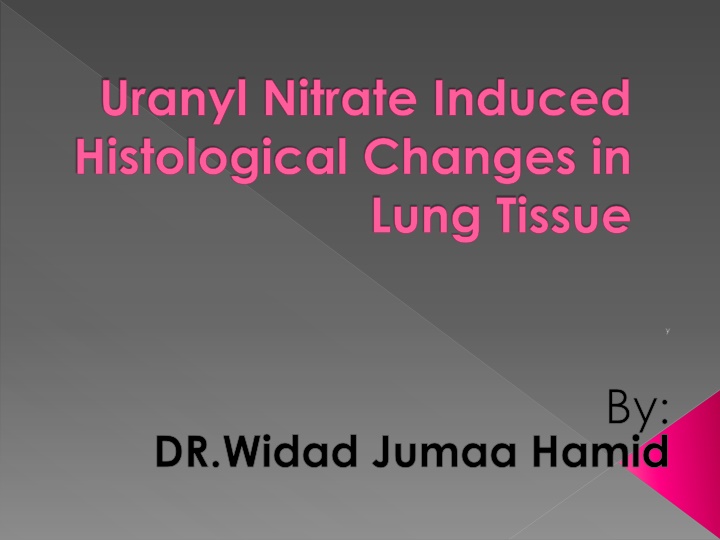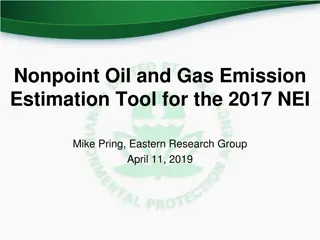
Histological Changes in Lung Tissue Induced by Uranyl Nitrate
"Explore the histological changes in lung tissue caused by uranyl nitrate toxicity, highlighting oxidative stress and cellular responses. Understand the impact of uranium exposure on lung health and potential health risks."
Download Presentation

Please find below an Image/Link to download the presentation.
The content on the website is provided AS IS for your information and personal use only. It may not be sold, licensed, or shared on other websites without obtaining consent from the author. If you encounter any issues during the download, it is possible that the publisher has removed the file from their server.
You are allowed to download the files provided on this website for personal or commercial use, subject to the condition that they are used lawfully. All files are the property of their respective owners.
The content on the website is provided AS IS for your information and personal use only. It may not be sold, licensed, or shared on other websites without obtaining consent from the author.
E N D
Presentation Transcript
Uranyl Nitrate Induced Histological Changes in Lung Tissue y By: DR.Widad Jumaa Hamid
Abstract Uranium is a naturally occurring radioactive material present everywhere in the environment. It is toxic because of its chemical or radioactive properties. Uranium enters environment mainly from mines and industry and cause threat to human health by accumulating in lungs as a result of inhalation. In our previous study, we have shown the oxidative stress induced by Uranyl Nitrate (UN) in rat lung tissue.
In the current study, uranium toxicity was evaluated in rat lung epithelial cells. The study shows uraniyl nitrate induces significant oxidative stress in rat lung epithelial cells followed by decrease in the antioxidant potential of the cells. Treatment with Uranyl Nitrate to rat lung epithelial cells was attributed to loss of total glutathione, thus the results indicate the ineffectiveness of antioxidant system s response to the oxidative stress induced by uranium in the cells. Histological study show slight degenerative changes in lung, pulmonary edema; inflammation of the bronchi; alveoli and alveolar interstices; edematous alveoli; lung lesions; minimal pulmonary hyaline fibrosis and pulmonary fibrosis. hemorrhage; emphysema;
Introduction Uranium, a heavy metal, is found widespread in nature, always in combination with other elements. Uranium has sixteen radioactive isotopes. Uranium isotopes, like other radioactive materials, emit ionizing radiation that is strong enough to damage or destroy living cells. Natural uranium emits gamma radiation and alpha particles. However, alpha radiation rarely appears without being accompanied by other emitters and because they penetrate a very short distance, these particles concentrate on a few micrometers of tissue and are therefore very harmful
The more soluble compounds of uranium, namely, uranium hexafluoride, uranyl fluoride, uranium tetrachloride, uranyl nitrate hexahydrate, are likely to be absorbed into the blood from the alveolar pockets in the lungs within days of exposure. Although inhalation products also are transported through coughing and mucoceliary action to the gastro-intestinal tract only about 2 percent of this fraction is actually absorbed into the body fluids through the intestinal wall. Therefore all of the research papers on acute effects of uranium refer to these soluble uranium compounds via inhalation . The main acute effect of inhalation of soluble uranium compounds is damage to the renal system, and the main long term storage place of these compounds in the body is bone..
The increase in ROS was significant . DU by inhalation resulted in increase of inflammatory cytokine expression and production of hydroperoxides in lung tissue as a consequence of the inflammatory processes and oxidative stress . therefore, uranium is known to induce oxidative stress with the earlier findings.
Increase in oxidative stress could result from failure of the antioxidant system that constantly counteracts the formation of oxidative species in the cells. Heavy metals like Pb, Cd, Hg and Cr are capable of inducing oxidative stress both in vivo and in vitro . The cause of the oxidative stress due to these metals pertains to failure in antioxidant status in the system. Therefore, to look for a similar cause with uranium we estimated the levels of glutathione (GSH) in uranium treated animals with UN and compared to control.
In addition to GSH, the antioxidant enzymes effective in scavenging free radicals . The above results suggest that the increase in ROS by UN in treated animals with UN were possibly due to the failure of the antioxidant mechanisms to counteract the rising oxidative species in lung. Therefore, supplementation of antioxidants could preferably counteract the oxidative stress induced by UN. As mentioned earlier, the route of exposure to uranium is largely through inhalation and therefore it makes the lung tissue as one of its target organs. DU of size <5 m can lodge deep into the lung alveoli, thus producing toxicological impact at the site of contact Uranium toxic studies in lung reported the toxic response to the metal)..
Methods: Twenty male rats (Rattus norvegicus) are used in this study, weighing (200- 210)mg (six weeks age) housed in the animal house of the collage of science, university of Baghdad. These animals were maintained of controlled temperature (25 2.2 C ) November 2012 to April 2013, allowed for accesses to water, and fed slandered rat chew added powder milk.20 male rats divided into two groups as follow.
Group I: Includes 10 animals used as control. Group II: Included 10 animals treated with 75 mg/kg body weight UN for one month (inhalition) . Blood samples were obtained by heart puncture and immediately placed into the tubes then allowed to clot, serum was separated after centrifugation for 15 minutes at 2000 rpm and the resulted serum were preserved frozen at (-18Co) unless immediate analysis was indicated. Serum glutathione is determined by a modified procedure utilizing Ellman,s reagent (Sedlak and Lindsay 1968).
Tissue Preparation: According to(Humanson , 1967:Bancroft and Stevens ,1977) . Samples (Lung tissue) were fixed in 10% neutral buffer formalin for 24 72 hours and processed in routine manner to provide paraffin blocks.From each formalin fixed paraffin embedded specimen the 5- micron section were cuts and mounted on clean slides. The 5 m paraffin sections were stained with Harris hematoxylin and eosin .
Statistical Analysis: The data of this study were complied into the computerized data file and the frequency, distribution and statistical description (mean, rang, and SD) were derived using SPSS statically software. We used statistical analysis of variance (ANOVA) test and least significantly difference (LSD) test by probability of less than 0.05 (P<0.05) according to (Duncan etal ,1983).
Results The data in table((1 ),showed significant incremen (P<0.05) in animals group G II (75mg /Kg UN) in MDA levels after one month of treatment compare with control. The data in table (1 ) showed significant reduction (P< 0.05) in animals group G II (75mg /kg UN)in GSH levels after one month of treatment compare with control . :
Table 1: Parameters of oxidative stress in Serum Parameter Group Normal group GI s Control (mean SD) treated with UN (mean SD) GII Number 10 10 MDA mol / g GSH mol / g 3.06 0.109 1.29 o.198 1.88 o.212 5.11 0.179
Histological study showed slight degenerative changes in lung ,pulmonary edema; hemorrhage,inflammation of the brochi, bronchial pneumonia, alveoli and alveolar interstices, edematous alveoli, lung lesions, minimal pulmonary hyaline fibrosis and pulmonary fibrosis, in the lung tissue treated with 75 mg/kg body weight UN for one month compare with control.
Fig. 1: Section in the lung of a control rat showing normal lung architecture with thin inter-alveolar septa (V). Notice the normal clear alveoli and alveolar sacs H& E: Mic. Mag. X 200.
Fig. 2: Section in the lung of a rat from group II Showing a congested blood vessel ( H ) with interstitial cellular infiltration (N) and presence of widening (W ) of other spaces. H& E: Mic. Mag. X 200.
H Fig. 3: Section in the lung of a rat from group II showing a congested blood vessel (H ) with interstitial cellular infiltration (N) and presence of eosinophillic material in thickened inter-alveolar septa accompanied by narrowing of some alveolar air spaces (V) and widening ( W ) of other spaces. H& E: Mic. Mag. X 200
Fig. 4: Section in the lung of a rat from group II showing a congested blood vessel ( H ) with interstitial cellular infiltration (N)and presence of eosinophillic material in thickened inter-alveolar septa accompanied by narrowing of some alveolar air spaces (V) andwidening ( W ) of other spaces. H& E: Mic. Mag X 200
Fig. 5: Section in the lung of a rat from groupII showing congested blood vessels (H) with swollen endothelial cells (W). Notice, extravasation of blood ( V ) The inset shows a higher magnification of swollen endothelial cells. H& E: Mic. Mag. X 200.
Fig.6: Section in the lung of a rat from group II showing massive cellular infiltration ( H ) with loss of normal architecture and extravasation of blood ( V ).H& E: Mic. Mag. X 400.









